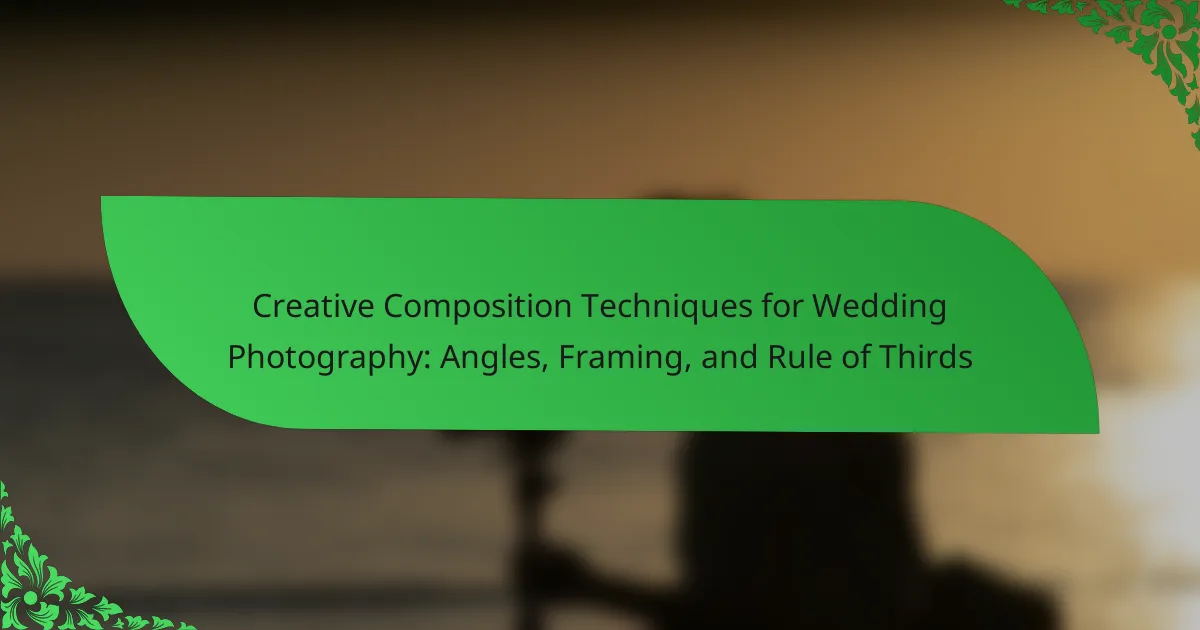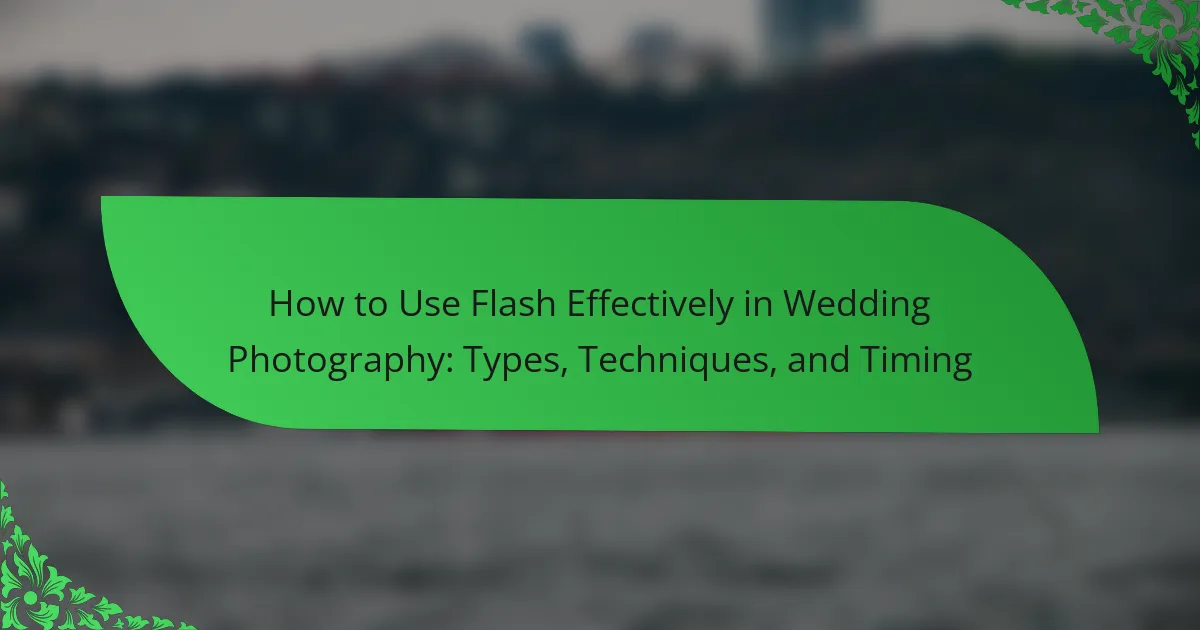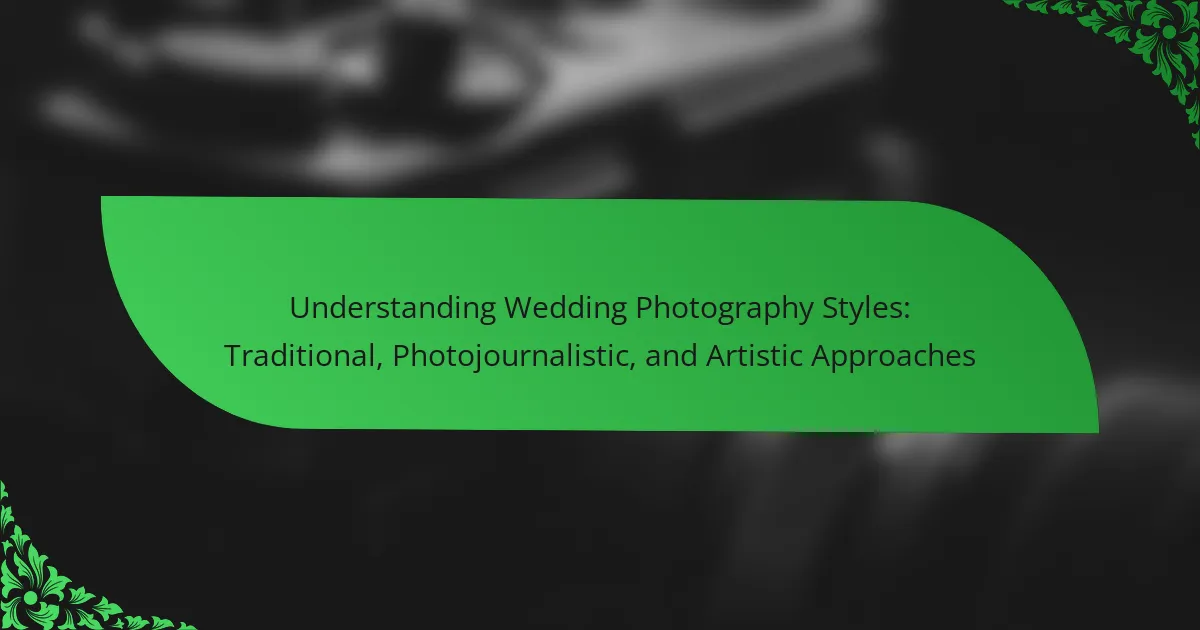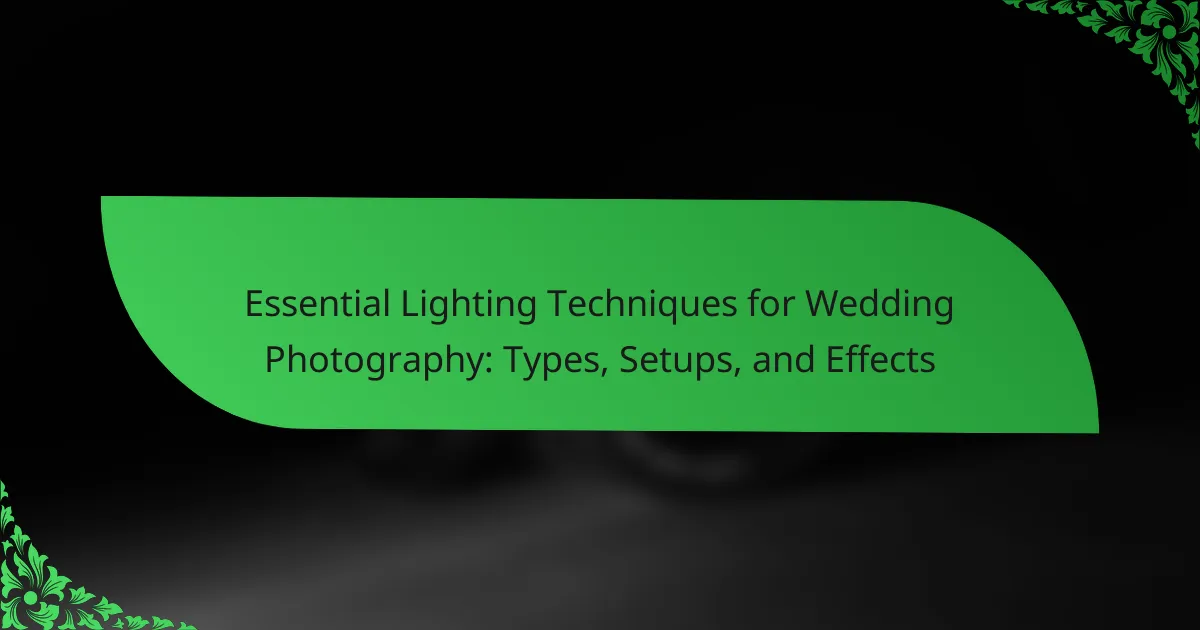Creative composition techniques in wedding photography enhance visual storytelling through methods such as angles, framing, and the rule of thirds. Angles provide dynamic perspectives that add depth, while framing uses elements within the scene to highlight subjects effectively. The rule of thirds divides the image into a grid, guiding the placement of key elements for a balanced composition. These techniques collectively contribute to capturing the emotions and significant moments of the wedding day, resulting in compelling and memorable photographs that narrate the event.
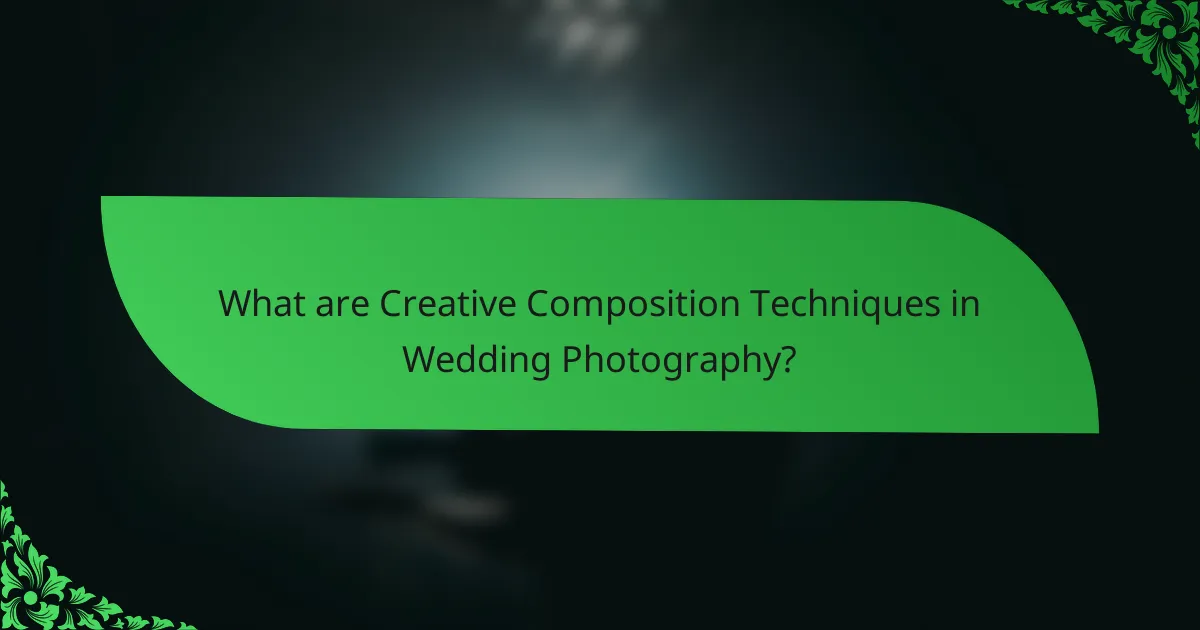
What are Creative Composition Techniques in Wedding Photography?
Creative composition techniques in wedding photography include various methods to enhance visual storytelling. These techniques often involve the use of angles, framing, and the rule of thirds. Angles can create dynamic perspectives, adding depth to images. Framing utilizes elements within the scene to draw attention to the subjects. The rule of thirds divides the image into a grid, guiding the placement of key elements. Together, these techniques help create compelling and memorable photographs. They contribute to the overall narrative of the wedding day, capturing emotions and moments effectively.
How do angles influence wedding photography composition?
Angles significantly influence wedding photography composition by affecting the perspective and emotional impact of images. Different angles can highlight specific moments, emotions, or details. For example, shooting from a low angle can create a sense of grandeur or importance. Conversely, a high angle can convey vulnerability or intimacy.
The choice of angle also affects the framing of subjects within the scene. Wide angles can capture more of the environment, enhancing the storytelling aspect of the photograph. Tight angles can focus on expressions and interactions, drawing viewers into the moment.
Furthermore, angles can guide the viewer’s eye and create dynamic compositions. The use of diagonal lines can add energy and movement to the image. Studies show that varied angles can lead to more engaging and visually appealing photographs.
In wedding photography, using angles creatively can transform ordinary moments into extraordinary memories.
What types of angles can be used in wedding photography?
Wedding photography can utilize various types of angles. Common angles include high angles, low angles, and eye-level angles. High angles capture the scene from above, providing a unique perspective. Low angles create a sense of grandeur by shooting from below the subject. Eye-level angles offer a natural view, making the images relatable. Additionally, Dutch angles can introduce a dynamic feel, tilting the camera for artistic effect. Each angle serves to enhance storytelling in wedding photography.
How do different angles affect the mood of wedding photos?
Different angles significantly affect the mood of wedding photos. High angles can create a sense of intimacy and vulnerability. They often emphasize the couple’s connection while minimizing distractions in the background. Low angles can convey strength and grandeur. This perspective often makes the subjects appear larger and more imposing. Side angles can introduce dynamic tension and drama. They can showcase the couple’s interaction in a more candid and natural way. Additionally, straight-on angles provide a classic and timeless feel. This perspective captures the essence of the moment without distortion. Each angle contributes uniquely to the emotional narrative of the wedding.
What role does framing play in wedding photography?
Framing in wedding photography serves to enhance the composition of images. It helps to focus the viewer’s attention on the main subjects, such as the couple or key moments. By using natural or architectural elements, photographers can create a visual border around the subject. This technique adds depth and context to the photos. Effective framing can also evoke emotions and convey the atmosphere of the event. Studies show that well-framed images are more engaging and memorable. Thus, framing is a crucial element in capturing the essence of wedding moments.
How can framing enhance the storytelling aspect of wedding photos?
Framing enhances the storytelling aspect of wedding photos by directing the viewer’s attention and adding context. It creates a visual boundary that isolates the subject, emphasizing emotional moments. This technique can highlight interactions between the couple and their guests. For example, using natural elements like trees or arches can frame a couple’s kiss, adding depth to the scene. Additionally, framing can evoke specific feelings, such as intimacy or joy. Studies show that well-framed images are more engaging and memorable. This is crucial in wedding photography, where capturing emotions is essential. Effective framing can transform a simple moment into a compelling narrative.
What techniques can be used for effective framing in wedding photography?
Techniques for effective framing in wedding photography include using natural elements, leading lines, and the rule of thirds. Natural elements, such as trees or arches, can create a frame around the couple. Leading lines, like pathways or fences, guide the viewer’s eye to the subject. The rule of thirds involves positioning the subject off-center to create a more dynamic composition. Additionally, using foreground elements can add depth to the image. Experimenting with different angles, such as shooting from above or below, can also enhance the framing. These techniques help to draw attention to the couple and create visually appealing images.
Why is the Rule of Thirds important in wedding photography?
The Rule of Thirds is important in wedding photography because it enhances visual interest and balance. This technique involves dividing the frame into nine equal parts using two horizontal and two vertical lines. Placing key subjects along these lines or at their intersections creates a more dynamic composition. It helps guide the viewer’s eye to focal points, such as the couple or significant details. Studies show that images composed using this rule are more engaging. This principle is widely recognized in photography education and is often taught to beginners for effective composition.
How does the Rule of Thirds guide composition in wedding images?
The Rule of Thirds guides composition in wedding images by creating balanced and visually appealing photographs. This technique involves dividing the frame into a grid of nine equal parts using two horizontal and two vertical lines. Placing key subjects along these lines or at their intersections enhances the focus and interest in the image. For example, positioning the couple at one intersection draws the viewer’s eye directly to them. This method also allows for negative space, which can convey emotion and context. Studies show that images following the Rule of Thirds are generally perceived as more engaging. Photographers often use this rule to ensure that important elements are not centered, which can lead to a static composition. By applying the Rule of Thirds, wedding photographers can create dynamic and memorable images that resonate with viewers.
What are common mistakes to avoid when applying the Rule of Thirds?
Common mistakes to avoid when applying the Rule of Thirds include misplacing focal points. Placing the subject in the center can lead to a static composition. Ignoring the background can distract from the main subject. Not considering the horizon line can cause imbalance in landscapes. Overlooking symmetry can lead to missed opportunities for dynamic images. Failing to adjust for different orientations can result in awkward framing. Neglecting to experiment with different placements can limit creativity. Lastly, sticking too rigidly to the rule can stifle artistic expression.
How can photographers transition between angles, framing, and the Rule of Thirds?
Photographers can transition between angles, framing, and the Rule of Thirds by understanding their relationships. Angles affect the perspective and mood of the image. Framing helps to draw attention to the subject. The Rule of Thirds divides the image into a grid, guiding placement for balance.
To transition effectively, photographers should first assess the scene. They can shift their position to find the best angle. Adjusting the framing can enhance the subject’s visibility. Applying the Rule of Thirds can create dynamic compositions.
Practicing these techniques in various settings improves skill. Experimenting with different angles and framing methods leads to unique results. Consistent application of the Rule of Thirds fosters better composition.
What are the key elements to consider for effective composition in wedding photography?
Effective composition in wedding photography involves several key elements. First, angles play a critical role in capturing unique perspectives. Photographers should experiment with different heights and orientations. Second, framing is essential to draw attention to the subjects. Using natural elements or architectural features can enhance the image. Third, the rule of thirds helps create balanced and engaging photographs. Placing subjects along grid lines can lead to more dynamic compositions. Additionally, lighting should be considered carefully. Proper lighting can dramatically affect mood and clarity. Lastly, attention to detail is vital. Small elements in the background can impact the overall composition. These elements combined create visually compelling wedding photographs.
What practical tips can improve creative composition in wedding photography?
To improve creative composition in wedding photography, photographers should utilize various techniques. First, applying the rule of thirds enhances visual interest. Photographers can position subjects along grid lines for balanced images. Second, experimenting with different angles creates dynamic shots. Low or high perspectives can offer unique views. Third, framing subjects with natural elements adds depth. This technique draws attention to the couple. Fourth, incorporating leading lines guides the viewer’s eye. Paths or architectural features can serve this purpose. Finally, paying attention to lighting conditions enhances mood. Soft, natural light often yields flattering results. These practical tips, grounded in established photography principles, can significantly elevate wedding compositions.
How can photographers practice and refine their composition techniques?
Photographers can practice and refine their composition techniques by regularly experimenting with different angles and framing. They should analyze their work critically after each shoot. This helps identify areas for improvement. Using the rule of thirds can enhance visual interest in images. Photographers can also study the work of renowned photographers to understand effective composition. Participating in photography workshops provides hands-on experience and feedback. Additionally, seeking critiques from peers can offer valuable insights. Consistent practice is essential for mastering composition skills.
What resources are available for learning more about wedding photography composition?
Books on wedding photography composition include “The Wedding Photography Field Guide” by Michelle Turner. Online courses from platforms like MasterClass and Skillshare offer structured learning. YouTube channels such as “The Art of Photography” provide free tutorials. Photography blogs like Fstoppers and PetaPixel feature articles on composition techniques. Additionally, workshops and local photography clubs can offer hands-on experience. These resources collectively enhance understanding of angles, framing, and the rule of thirds in wedding photography.
Creative composition techniques in wedding photography focus on enhancing visual storytelling through the use of angles, framing, and the rule of thirds. The article explores how different angles can influence the mood and perspective of wedding images, while effective framing techniques help highlight key subjects and moments. Additionally, the rule of thirds is discussed as a vital principle for creating balanced and engaging compositions. Practical tips for improving composition skills and resources for further learning are also provided, making this a comprehensive guide for photographers looking to elevate their wedding photography.
